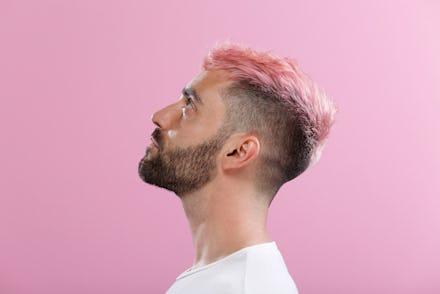Switching between vibrant hair colors is easier than you think

From bright blues to trendy pastels, vibrant hair colors are still one of the most popular ways to refresh your look. Kylie Jenner and many of her rich peers tend to rely on wigs, which can cost up to $4,000 (an unfeasible option for the non-Jenner color chameleons of the world. Some bloggers and Instagram influencers, however, utilize a simple beauty hack for rapidly switching unnatural hair colors that you may remember from grade school art class: the color wheel.
"The science of the color wheel dictates all hair coloring. The color wheel is the basis of all professional color lines and is also used to determine outcomes," New York City hairstylist Hayleigh Hatcher said in a phone interview.
It's a trick I learned myself when I started "de-gothing": deciding to grow out the black boxed dye that I'd slathered my hair in for two years. I jumped on the "color root" trend and had my naturally light brown roots bleached out and dyed blue.
After about a month of blue I decided it just wasn't for me; I wanted to eventually have red. However, when I tried putting some red hair dye on top of the faded blue, I just got purple (as red plus blue equals purple). My plan was foiled!
That is, until I learned about the color wheel. Those who switch their hair colors regularly often have a carefully constructed plan for how to get from color A to color B. For instance, to switch from green to purple, they might move along the color wheel, gradually switching from green, to blue, then purple and so forth. To get the look I wanted, I'd have to create a plan for myself.
After washing out the blue to a very faded color, I applied Manic Panic Purple Haze dye. I'm going to gleefully rock purple roots until that fades out, and then I'll move onto a magenta color like Manic Panic Fuchsia Shock. After that's washed out, I can put red on top, and voila! A Joan-from-Mad-Men red will be attainable.
Of course, it's not quite as simple as placing color on top of color, which can result in a muddy look. Most of these looks are created with Manic Panic or similar dyes, which are semi-permanent, meaning they fade gradually with each wash. While less damaging than permanent boxed dyes, this also means they don't "lift" your current hair color, or lighten it to make room for the new color.
Applying a bright colorful dye on top of darker hair can give you more subtle color and vibrant highlights. However, to get the brightest possible hot pink or blood red, it's necessary to bleach new growth. "Bleach is the true essence of donning the unnatural hues — and that's a whole other level of commitment. Bleach used unprofessionally can be a tragedy!" Hatcher said in a phone interview.
While following the color wheel doesn't mean you'll have to re-bleach all your hair each time, if you want the most vibrant color, you'll have to bleach any new growth, unless of course, you have naturally very light blonde hair.
Keep in mind, regular color change along with any additional styling can take a toll on your hair, so proper care is of utmost importance. "If you are constantly coloring your hair it's imperative to keep up with cuts, use a really good shampoo and conditioner, and avoid excessive heat styling," Hatcher said. While Hatcher says long hair buys you a little more time, she recommends coming in for a cut every eight weeks. For products, she recommends the "Love" line by Davines.
So, take good care of your hair, follow the color wheel, let your current color fade out and for brightest results, bleach any new growth. If you're dedicated enough to follow these instructions, you can have blue hair for spring and be ready to settle into an oxblood red for fall.